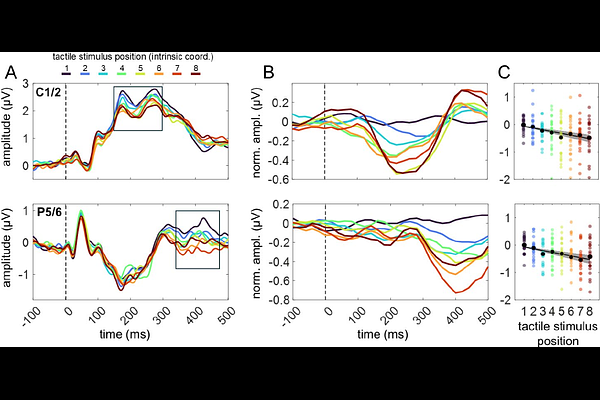The spatial coding of touch is defined in intrinsic, limb-specific coordinates: an EEG study

The spatial coding of touch is defined in intrinsic, limb-specific coordinates: an EEG study
Peviani, V. C.; Elmas, H. H.; Medendorp, W. P.; Miller, L. E.
AbstractThe brain localizes touch in space by integrating tactile and proprioceptive signals, a process known as tactile remapping. While it is often assumed that the remapped touch is encoded in an extrinsic, limb-independent reference frame, an alternative view proposes that touch may instead be represented within an intrinsic, limb-specific coordinate system. To test these hypotheses, we used electroencephalography (EEG) and a novel tactile stimulation paradigm in which participants received touch on their hands positioned at various locations relative to the body. Previous findings suggest that neural activity in primate sensorimotor and parietal regions monotonically encodes limb position. We therefore analyzed amplitude gradients in somatosensory evoked potentials (SEPs) to test predictions from each coding scheme. If touch is coded extrinsically, neural gradients should reflect changes of the external stimulus location, regardless of the limb. If coded intrinsically, gradients should be tied to the position of each limb and mirror each other between hands. Both univariate and multivariate EEG analyses found no evidence for extrinsic coding. Instead, we observed neural signatures of limb-specific, intrinsic spatial codes, the earliest emerging about 160 ms after touch in centro-parietal regions, later shifting to fronto-temporal and parieto-occipital areas. Furthermore, a population-based neural network model of tactile remapping successfully reproduced the observed gradient patterns. These results show that the human brain localizes touch using an intrinsic, limb-specific spatial code, challenging the dominant assumption of extrinsic encoding in tactile remapping.